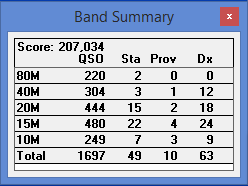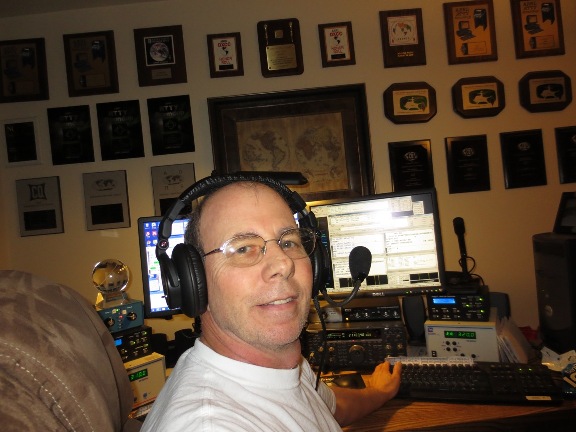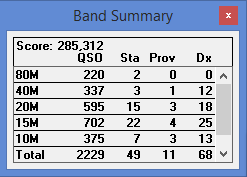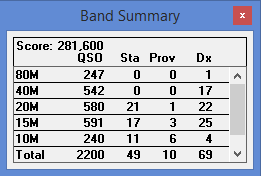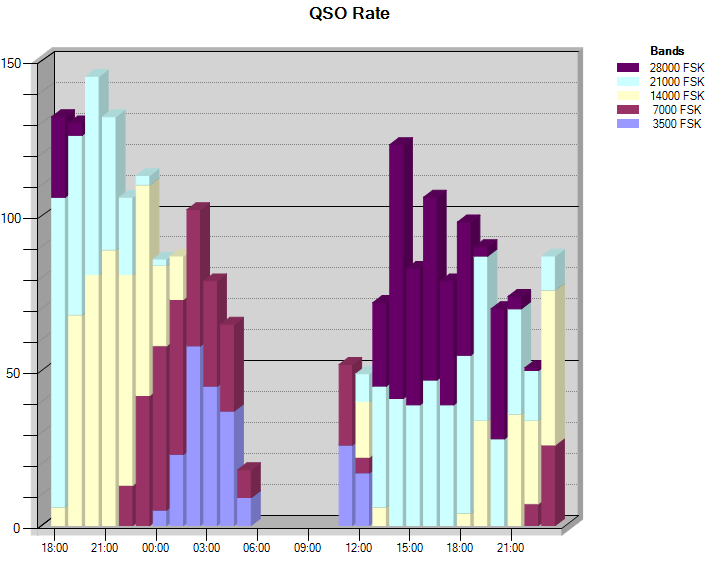AA5AU Contest Notes – 2015 ARRL RTTY Roundup
For the 27th running of the ARRL RTTY Roundup, I decided to go Single Op Low Power Unlimited. This is the second year this classification has existed and it would be my first time entering this category. I was looking forward to the change. The Roundup had become a bit boring for me after all these years. Perhaps using the Packetcluster would spice things up a bit. I have always done well using the Packetcluster in other contests, so it would be interesting to see if operating assisted would bring the fun back into the contest that has the highest rates for me.
Saturday Morning
I awoke Saturday morning at my usual 1200Z (6 AM local time), but I was able to stay in bed and relax for another two hours. Since the contest starts at 1800Z, which is noon local time, I had plently of time to put any finishing touches on the station. The first thing I did was go outside and reconnect the 2-element SteppIR to a feedline going into the shack. Back in November I installed a new 160M antenna and didn’t have a penetration for another coax run into the house so I used the feedline going to the 2-element SteppIR.
Everything was still wet outside that morning but it wasn’t raining as it had the night before. It was a warm and muggy morning with temperatures already in the 70s. The humidity was so thick it felt like you could cut it with a knife. After reconnecting the antenna, I taped up the connector and went inside to test it. It tested fine; one less thing to worry about.
My biggest concern today would be the weather. A warm front was pushing moisture in from the Gulf of Mexico to the south and a cold front was expected to arrive from the northwest sometime around sunset or later. There were conflicting forecasts on when this rough weather would arrive. When two such fronts collide, it causes severe weather. One thing for sure, there would be thunderstorms. The keys would be when they would arrive and how severe would they be.
The shack was ready to go. It pretty much stays connected for contesting so I needed to burn some time. I went outside and took down the Christmas decorations and packed them into the attic. I then weeded the flower garden. I took a shower and got back into the shack about 1700Z when suddenly a loud tone came across the TV in the other room. It was a tornado watch. I checked the radar and saw scattered rain and thunderstorms in the region but nothing real serious yet. The frontal boundry was still well out to the west. I wasn’t concerned because there’s nothing you can do about the weather.
I took a look at the propagation numbers but I didn’t write them down. I think the solar flux was around 145. The A index was something like 13 and the K might have been 3. The numbers weren’t great but I wasn’t worried about the propagation. There’s nothing you can do about that either.
The Start – 1800Z
So all was right in the world that morning as I sat waiting on 1800Z. I staked out the low ends of 10 and 15 meters. I always like to try to stay low in the band at the start. It doesn’t always work out since I’m low power, but it’s a strategy. Start low then move high – way high, like up over .100 on 10, 15 or 20 meters.
Running SO2R, I had an Icom IC-756 PRO III on the left and a Kenwood TS-870 to the right. These have been my radios for many years and they work fine. At 1800Z, I started alternating CQ on 10 and 15 meters at 28080 and 21080 kHz respectively. Calls started rolling in immediately on 15 meters but nothing on ten. After only two replies in the first seven minutes on ten meters, I switch to S&P on that radio. It’s not unusual for ten to not be real good at 1800Z in Louisiana. Fifteen was great and the calls kept coming, SP3GXH, W1HY in RI, VE2RYY is Quebec, WX1S in NH, N3XLS in PA, KK6L in CA, DL3BQA and W7OM in WA. I was beaming at 30 degrees north with the 3-element SteppIR on 15 meters so it was great to see I was working US East Coast, Canada, Europe and even US west coast at the same time.
I was able to find stations to work on ten S&P but after about 45 minutes, I could tell 10 meters was just not going to supply the rate I needed, so I moved the Kenwood from 10 to 20 meters and did some S&P. But there were not many stations on 20 yet, so I went back to ten and ran on 28080 kHz again. At 1910Z, I went back to 20 and worked one or two stations S&P before settling on 14082 kHz where I started running. The first hour rate was 132 contacts with 100 of them on 15 meters. I don’t recall ever working a hundred stations on a single band to start the Roundup. It was an excellent start. The second station to call in on ten meters was KJ9C in Montana. It’s always good to get the more rare state multipliers early. I didn’t know it at the time, but all the US and most of the Canadian multipliers would be available in abundance this weekend, including DC.
21080 kHz was quite fruitful and I was able to stay there for nearly an hour and a half before the QRM got too bad. I worked a couple stations S&P, then moved the Icom up to 21117 kHz, where I started running again. The run on 20 meters was starting to pick up, then it got real good as I was able to hold onto 14082 khz for nearly five hours! My rate for the first six hours were 132, 130, 145, 132, 106 and 113. These are great numbers and I was very happy indeed as I was able to run on both 15 and 20 meters for most of this time. Any time you can run on two radios for this long with low power, you have to be pleased and I was.
Using the Packetcluster in the Roundup was new, but it is not a new strategy for me. You have to be careful about using the Packetcluser and not get caught up chasing packet spots too early in the contest. I decided to use the ‘cluster in the Roundup much as I do in CQ WPX RTTY and that is to not use it early in the contest. I had it running and could see callsigns populating the bandmap but I resisted the temptation to chase them right away. The Roundup is strictly a rate contest. It’s more important, for me anyway, to work as many stations as possible and let the multipliers come to me for the first few hours. When the rate slows, then it’s time to chase multipliers and even non-multiplier stations when the runs slow to the point where the rate needs to be supplemented by chasing spots. That time, when to start chasing spots, actually came sooner than I had planned.
Sometime just after 2200Z, as the rate on 15 slowed, I decided to go check 40 meters. Conditions were still good on 15 but the rate was falling. It was still a bit early for 40, but I was able to work a few stations, then I went back to 15 meters. My plan was to hop back and forth between 15 and 40 to keep the rate up. I started using the Packetcluster more and more just to work stations and to see how it flowed with my runs. It was easier than S&P but not necessarily faster. Sometimes I’d click on a spot and there would be nothing there. This happens on RTTY because not everyone is running FSK and thus, not everyone’s radio has the same frequency on their dial. And, of course, some stations I just can’t hear because the path is not there.
I pride myself on my ability to do rapid S&P. It’s something I have worked on for many, many years. Using a combination of S&P, and clicking on Packet spots, I was able to keep the rate up to levels higher than what I normally do when running unassisted. It was good stuff and I started getting into a nice flow. Also, I could be running on a radio, not get a answer to my CQ, click on a packetspot, if they were there – work them or not, go immediately back to my run frequency and call CQ again. Then I started doing this while running on both radios and it was working quite nicely and was really pretty cool to do. It’s the reason why I wanted to do unlimited in the first place and it was working far better than expected. And it was loads of fun.
A Stormy Night
Just after 0000Z, I moved from 15 to 40 permanently and 20 meters was still going very strong. When 15 slows and 40 is not quite in yet is a point in time when the rate normally slows so I did not have a problem seeing the rate fall to 86 from 0000-0100Z and 87 from 0100-0200Z. My expectation is to keep the average rate above 100 per hour as long as possible. Since I had such a great start, seeing the rate drop didn’t bother me.
My 40 meter antenna situation is not as good as it used to be. I only have a simple 40 meter inverted vee with the apex at about 40′ off one of my towers. At one time I used to have a Cushcraft D40 rotatable dipole at 70′ and it was an absolute killer antenna for contesting. Then after my towers fell in Hurricane Katrina, I rebuilt the D40 and had it at 65′ and it still worked great until Hurricane Gustav took that tower down in 2008. I then had a 3-element SteppIR with the 40-meter option at 55′. After it was destroyed by Hurricane Isaac in 2012, I rebuilt my taller tower to only 45′ and now the best I can do on 40 meters is this inverted vee. I have an inverted vee for 80 meters at the same height, off the same tower. These are not killer low band antennas and my low band numbers are nowhere near what they have been in the past. I don’t like it, but my rate is going to fall when I hit the low bands. Because of this, I try to stay on 15 & 20 meters as long as possible. Remember, this is a rate contest and it doesn’t matter where the rate comes from.
At 0029Z, I checked 80 meters for a few minutes. I worked a couple stations S&P, but there wasn’t much there so I went back to 20. At 0125Z, I went from from 20 to 80 permanently for the night. 80 was noisy and I knew why. I checked the radar and there was a line of thunderstorms in northwestern Louisiana. It was only a matter of a couple hours before they got here. They appeared to be moving slowly toward me. With any luck, I’d get a couple of hours on the low bands.
The move to 80, along with running on 40, helped the rate go over 100 once more. Between 0200-0300Z I worked 102 stations, but as the storms got closer, the static crashes got worse and the rate fell to 79 between 0300-0400Z and to 65 from 0400-0500Z. Around 0515Z, I started hearing thunder. A check of the radar confirmed the storms were nearly on top of me so I shut everything down. I was hoping to go all the way to 0700Z, but that wasn’t going to happen. I disconnected all the antennas from the SixPak, removed the cables out of the back of SteppIR controllers, and unplugged power from the shack. By the time I went to bed, it was around midnight (0600Z). I had 1195 contacts in eleven hours and 15 minutes. So I had still been able to maintain the 100 QSO per hour rate despite the low band struggles. I was pleased.
Restless
I don’t know if the change in plans messed me up or what, but I could not go to sleep. I tossed and turned for what seemed like hours. I know how important sleep is and that I needed to get as much as I could. But I just couldn’t sleep. I did finally nod off but I doubt I got more than an hour of good sleep. When the alarm went off at 1100Z (5 AM local), I jumped right out of bed. There wasn’t time for breakfast, so I went into the shack and reconnected every back up. At 1115Z, I was ready to go on 40 and 80 meters again. This was new territory for me. I’d never operated this early in a Roundup.
The first 45 minutes back, I had only 52 contacts followed by 49 for the whole next hour between 1200-1300Z. This is the very reason why I normally go to 0700Z the first night so I can restart at 1300Z. From 1300-1400Z, as I moved to 15 and 20 meters, then from 20 to 10 meters, the rate jumped to 72 as both ten and fifteen meters started to open to Europe at sunrise. My average rate had fallen below 100 per hour and I would not ever catch back.
Clear Skies Sunday
Once both bands were fully open, the rate jumped to 123 between 1400-1500Z. The sun was fully up now and it was a clear beautiful day. However, something must have happened between 1500-1600Z because the rate dropped to 83, but then jumped back up to 106 between 1600-1700Z. Propagation was up and down. After that, the Europeans started dropping off. I worked EA1AST at 1704Z on 10 meters and that was it for Europe for both bands. Then both bands got real good to the east coast United States and Canada and the rate increased to 106 between 1600-1700Z. This roller coaster would last for the rest of the contest.
After 1700Z is when my rate normally falls. This is usually the time when 10 goes flat and 20 is not good enough for decent rate. But this year was different because of the Packetcluster. Ten stayed good and 15 meters was still rockin’. I was able to supplement my runs by clicking on packet spots, then jumping back to my run frequency and it was working really well. After 1800Z I went to check 20 meters, but there wasn’t much there so I went back to ten but it started to slow a bit. The rate from 1700-1800Z was 79 and that was pretty darn good. I was having so much fun that I nearly missed when I surpassed the current low power unlimited record. The current record is 206,976 points set last year by Mark, N2QT. At 1712Z, I hit 207,034 and did a screenshot of my Band Summary. It was great passing the record with just under seven hours to go.
Twenty got a little better between 1800-1900Z and the rate jumped to 98. But 20 was not as good as I expected it to be so I basically went back and forth between ten and twenty on one radio while continuing to run on 15 meters on the other radio. And the beauty of all this was that I was using my 2-element SteppIR at only 35′ on 15 meters and it was working great as it had in the past. Not sure why this antenna is so good on 15, but it is. Yes, 2 elements at 35′ and it works. This allowed me to use the better antenna (3-element SteppIR at 45′) on 10 and 20 and that worked well too. The rate between 1900-2000Z was 90 and I was feeling really frisky. So I pulled out my camera and snapped a couple selfies. Really? Yeah, really…
So this is what AA5AU looks like after about 20 hours of Roundup. I certainly had something to smile about even though I looked a little rough.
Stretch Run
Normally after 2000Z, my rate falls until the last two hours of the contest. I could not get any good runs going on 20 despite the band being packed full of signals. So I just kept at what I was doing with keeping one radio on 15 and going back and forth between 10 and 20 on the Icom. Ten hung in there really well for me. I was working everywhere on 10 and 15 meters including close in states like Arkansas, Alabama, Mississippi, Georgia and Texas.
From 2000-2100Z, the rate was 70, mainly between 10 and 15 meters as 20 was still struggling. Finally 20 meters started getting better after 2100 and the rate increased slightly to 74. But in order to keep the rate up, I had to go to 40 meters as ten meters started going away in a hurry. Between 2200-2300Z, the rate dropped like a rock to only 51 as 10 was gone, 15 meters started going away, 40 meters wasn’t quite ready yet, and 20 was still struggling. And to make matters worse, I had worked just about every unworked spot on the bandmap. Finally after 2300Z, 20 meters started coming in and so was 40 and the final hour rate was a respectable 87. I logged two stations in the final minute on 20 meters and shut it down. The results appear to be very good as shown by my claimed score in the Band Summary window.
It’s very close to my Single Operator Low Power (unassisted) world record claimed score of 2012 (shown below). That 2012 effort resulted in an official score of 274,944 points after log checking and a new SOL world record.
Observations
I would hope that my first try at Single Operator Low Power Unlimited would result in a score higher than my best unassisted score and it appears it will. Although I raved about how good band conditions were, when I checked the numbers after the contest, it’s obvious that propagation was not that good at all. I think the huge number of participants made up for the lack of propagation. Here’s were what the numbers were at the end.
As far as the score is concerned, there appears to be room for improvement. Perhaps if the low bands had been better Saturday night and propagation better on Sunday during the day, I may have been able to achieve the 100 QSO per hour rate goal for the entire 24-hour contest period. This is my goal for next year although I’m not sure it’s obtainable with my present low band antennas. Not sure what improvements could be made there, but it’s worth some thought. The encouraging thing is that if ten meters is still with us next year, I might be able to do better. And that would be really great!
73, Don AA5AU
Complete SH5 Log Analysis here.
Complete CBS Log Analysis here.
Equipment:
Icom IC-756 PRO III transceiver
Kenwood TS-870 transceiver
Dunestar 800 all-band filter (2)
Dunestar 2-radio headphone selector
Heil Pro Set Elite headphones
JPS NIR-12 Dual DSP audio filter (2)
Dell Desktop PC running Windows 8.1
Dell Desktop PC running Windows XP
Dell 22″ widescreen LED monitor
Dell 19″ LCD monitor
WriteLog for Windows contest software
WX0B SixPak antenna switch
Antennas:
3-element SteppIR yagi @ 45′
2-element SteppIR yagi @ 35′
40 meter inverted vee with apex @ 40′
80 meter inverted vee with apex @ 40′
Pixel Loop receiving antenna

